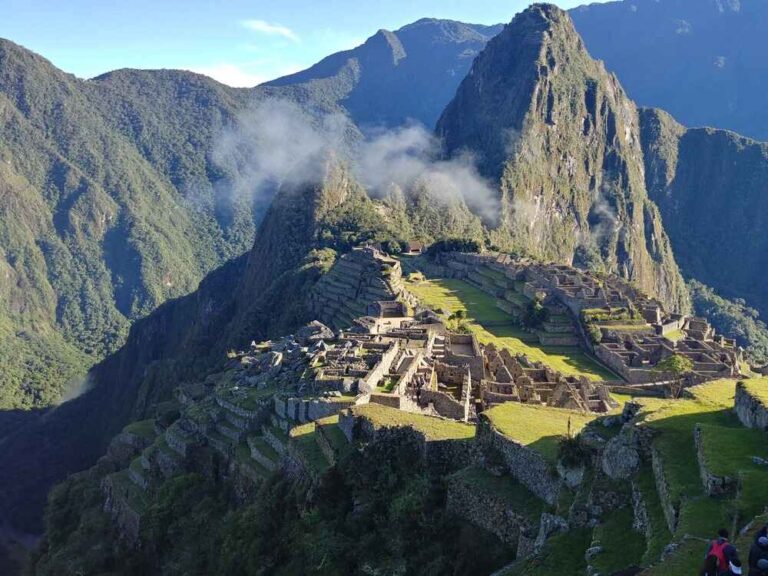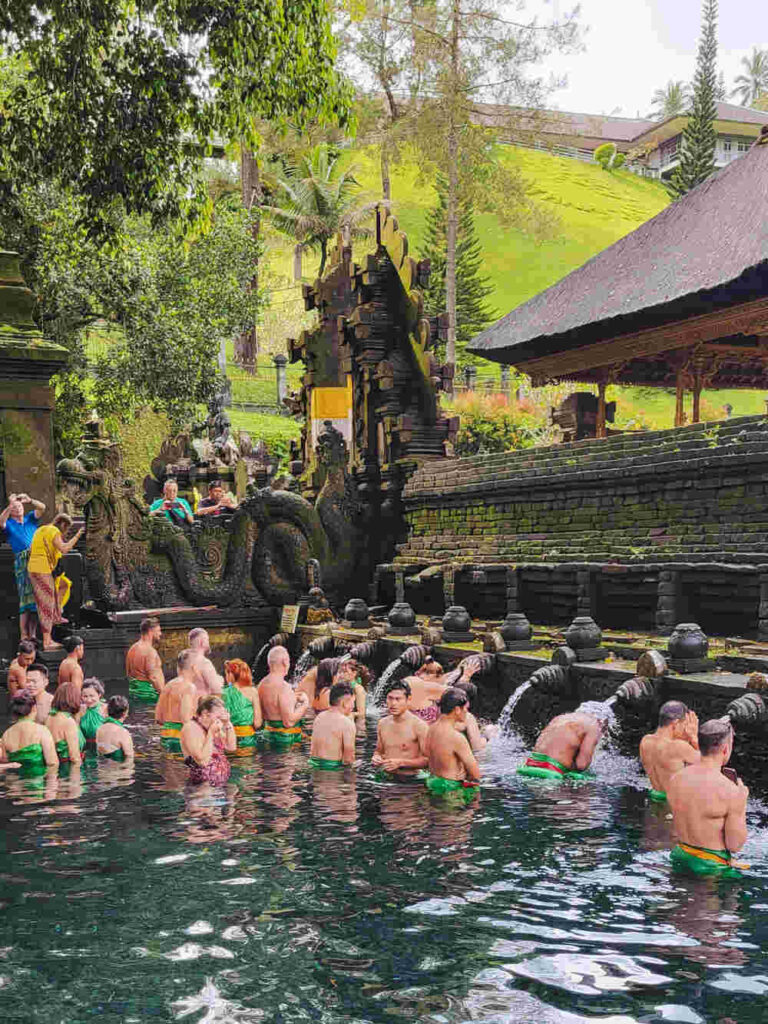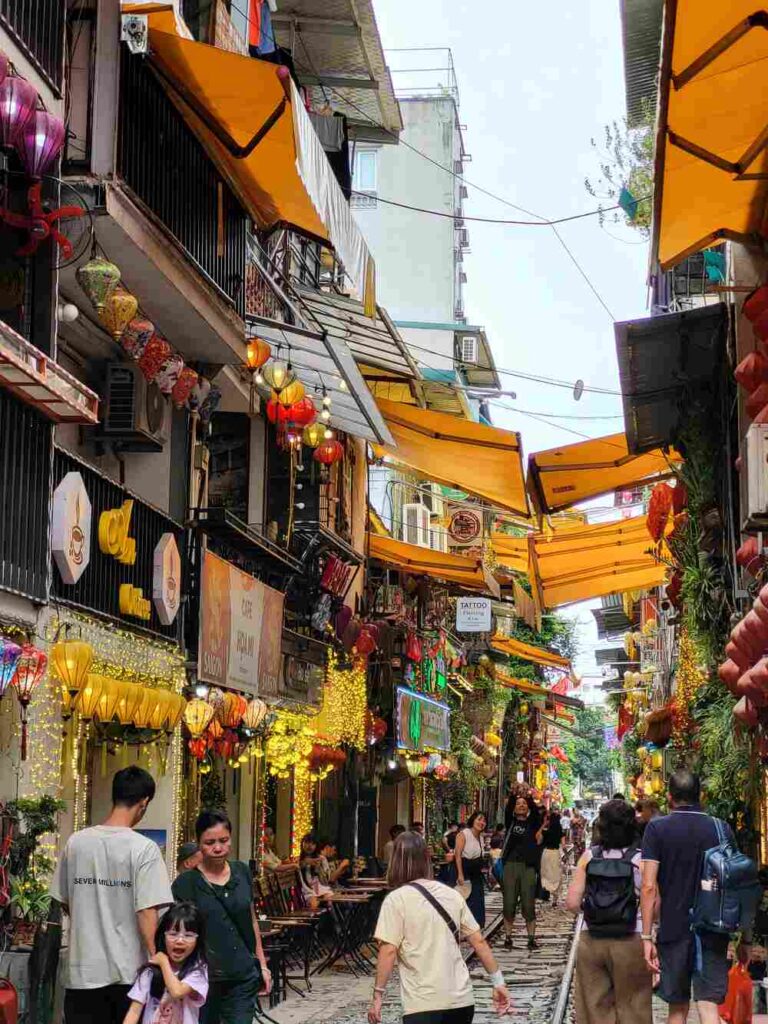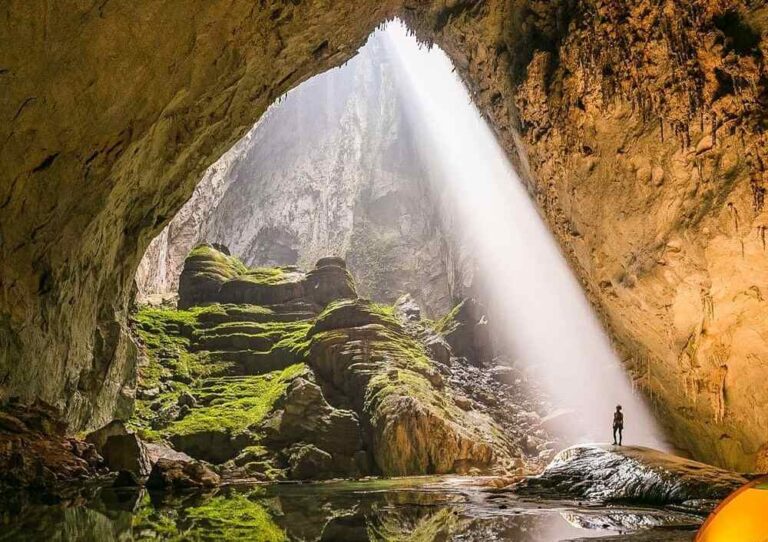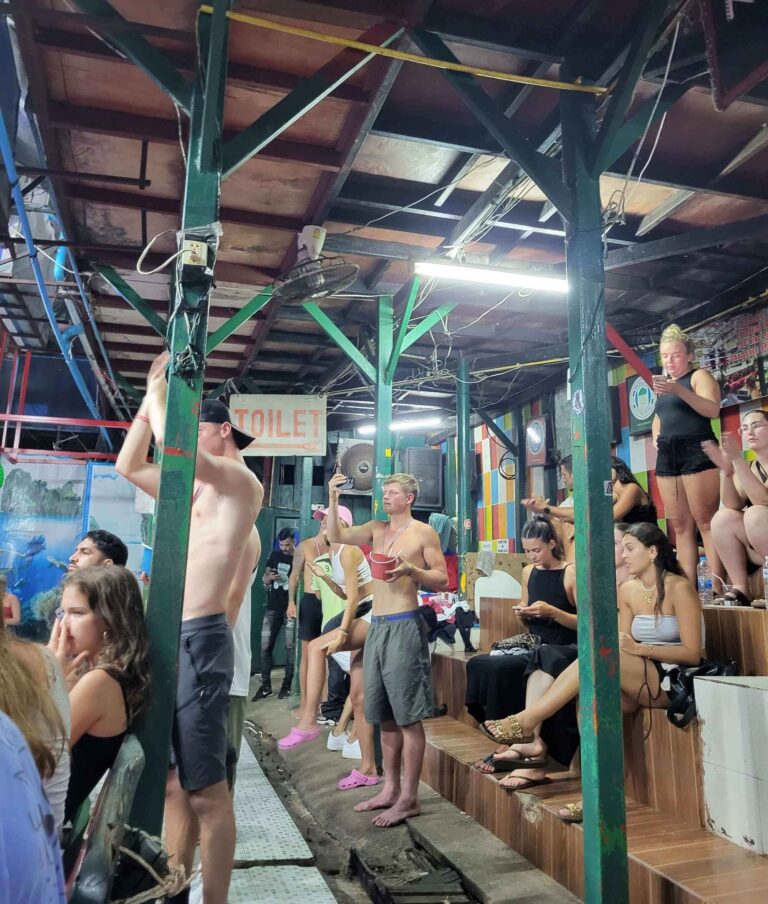In late 2024, I spent a month exploring northern Vietnam, diving deep into the culture and chasing every jaw-dropping landscape I could find. And how did I kick off this unforgettable adventure? With a 4-day motorbike ride through the legendary Ha Giang Loop experience!

Let me tell you, this was hands down the strongest start to any trip I’ve ever had. Nothing else quite compares to the feeling of cruising along cliffside roads, surrounded by towering mountains, terraced rice fields, and winding rivers that look like they’ve been plucked from a movie scene.
What is the Ha Giang Loop?
The Ha Giang Loop is a multi-day journey in northern Vietnam. The loop drives through the rugged and ridiculously beautiful mountains of Ha Giang province. It’s more than just epic views (though there are plenty of those), you’ll pass through remote villages, stay with local families, and get a glimpse into the lives of the many ethnic minority groups that call this region home.
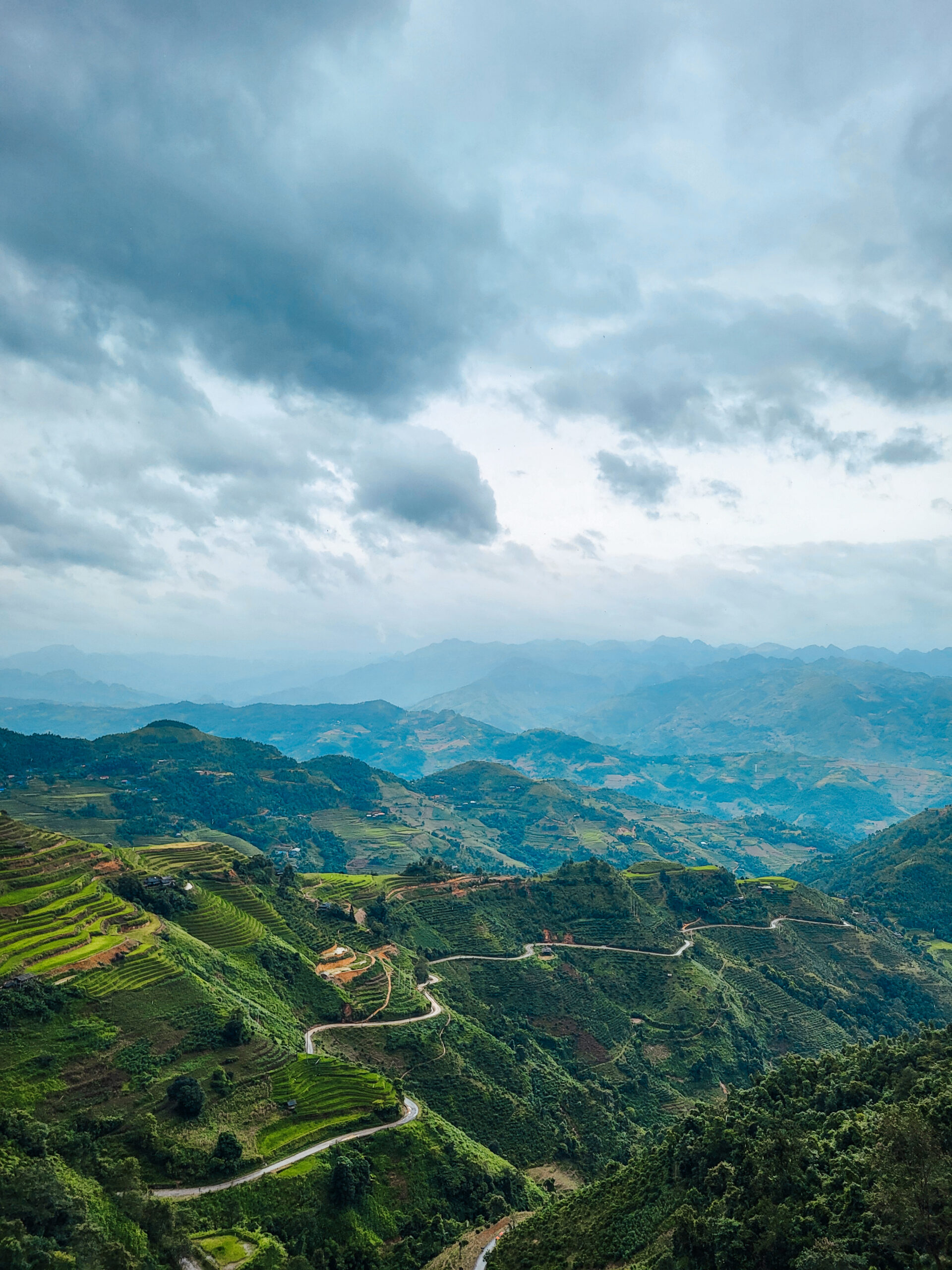
Whether you’re riding solo or joining a group, this is one adventure that blends culture, nature, and adrenaline in the most unforgettable way.
So buckle up your helmet, because I’m about to take you through my full Ha Giang Loop experience, what to expect, why it’s worth it, and how to make the most of it.
Why Go to Ha Giang City?
If you plan to do the Ha Giang Loop (and you should), your adventure starts in Ha Giang City! Ha Giang is the gateway to one of the most stunning and untouched regions in the country. This mountainous city is surrounded by surreal landscapes made up of razor-sharp limestone peaks, deep valleys, and endless layers of misty green mountains.

Ha Giang City itself is where most travelers begin and end the Loop. It’s the base for all the action: where you’ll rent your motorbike, meet your group or guide, get geared up, and mentally prepare for the ride of a lifetime.
It’s also a great place to rest after the overnight bus journey from Hanoi, stock up on essentials, and grab some delicious food before heading into the wild.
About Ha Giang Province
The entire Ha Giang region covers a massive area, about 135 kilometers, with winding roads that snake through jaw-dropping mountain passes and tiny villages tucked between the cliffs. It’s home to 22 different ethnic minority groups, each with their own unique traditions, clothing, and culture.
As you ride through the Loop, you’ll pass through vibrant local markets, meet incredibly welcoming people, and witness a way of life that feels worlds away from the big cities.

This isn’t just a road trip, it’s a deep dive into one of Vietnam’s most authentic and breathtaking regions. With twisty mountain roads, unreal scenery, rich culture, hearty local food, and warm-hearted people, Ha Giang is truly a gem that deserves a spot on every traveler’s itinerary.
My Ha Giang Loop Experience
Booking With Bong Hostel
On my second night in Vietnam, I decided it was time to get serious about the Ha Giang Loop. I had heard too many incredible things to pass it up, so I started hunting for the best tour providers. That’s when I stumbled across Bong Hostel, and everything about it just felt right.
Bong Hostel is well-known among backpackers in Vietnam. They started in Hanoi, but have been organizing Ha Giang motorbike tours for years, working closely with locals in the region. They’re a tour company with real experience, and they’ve built a strong reputation for offering well-organized, safe, and super fun trips through the mountains.
What stood out to me immediately was that they run their own shuttle between their hostels in Hanoi and Ha Giang. So not only do they take care of the loop experience, but they also handle all the transportation to and from the region. And once the tour is over? They can help you get to your next destination, whether that’s Sapa, Hanoi, Ninh Binh, or wherever your Vietnamese journey takes you next.

After checking out a few other companies and reading way too many reviews, Bong had the highest ratings and the smallest group sizes, which sealed the deal for me. I’m all for smaller tours. They’re more personal, easier to connect with people, and just feel more authentic. So, without overthinking it, I signed up that night.
The ride felt like door-to-door service, smooth, easy, and zero stress. When we arrived at Bong Hostel in Ha Giang, we were checked in, given beds for the night, and had a full rundown of the Ha Giang Epic Tour. That evening was all about meeting the crew, settling in, and prepping for the ride.

Heads up: you’re only allowed to bring one small backpack on the tour. Since you’ll be riding with an easy rider (unless you’re driving yourself), there’s only so much space on the bike for you, the driver, and your gear. So you need to bring a small bag and pack light. Once you’re out there on the open road, surrounded by mountains, it’s all worth it.
The Start of the Adventure
On the first day, we got to meet our driver. After short introductions, I hopped on the back of a bike and we rode out of Ha Giang City. Almost immediately I we were surrounded by towering limestone peaks and dramatic mountain passes. There’s something so freeing about riding through that kind of landscape; it felt like the real beginning of adventure.

Every day we split into our small groups of 6-8 bikes and drove through the mountain passes. We would get a full tour of the region, the history and see the popular spots with the best views, then meet up with the rest of the groups at lunch and dinner to talk about the day and compare photos!
Our small group quickly bonded over shared awe, endless laughs, and something known locally as “happy water.” If you haven’t heard of it yet, happy water is essentially homemade rice wine that’s offered generously (and I mean generously) by locals at mealtimes, especially at the homestays. Let’s just say it turns strangers into friends very quickly.
Iconic Stops on the Ha Giang Loop
One of the highlights early on in the ride was winding up the Tham Ma Pass, and wow, this stretch of road is straight out of a movie. The pass consists of dramatic switchbacks snaking up a mountain. You get to see this and ride with motorbikes, weaving your way through the curves and epic views.
Tham Ma Pass is famous for its dizzying “S” shape and is often called the “Heaven’s Gate of Ha Giang”. Historically, it was used as a test for horses: only the strongest ones could carry loads to the top. Today, it’s a photo spot and a rite of passage for anyone doing the loop.
Lung Cu Flag Tower
Then came a moment I’ll never forget. We were literally riding just a stone’s throw from the Chinese border. No fences, no big signs, just the mountains acting as this ancient natural border between two countries. It gave the whole experience this wild, surreal feeling, like we had truly reached the edge of something.

To really take in the scope of it all, we were taken to the Lung Cu Flag Tower, which stands proudly at Vietnam’s northernmost point. This tower is a symbol of Vietnamese pride and sovereignty. It marks the official border area.

From the top of the tower you get a full panoramic view across the lush valleys and rolling hills of the Vietnam-China border. It’s both beautiful and meaningful—standing at this peaceful monument, looking out across two countries, you really feel the weight of history and geography converging in one place.
Bac Sum Pass
And let’s not forget Bac Sum Pass, another iconic lookout on the loop. This one is often the first “wow” moment of the trip, especially if you’re riding from Ha Giang City toward Dong Van. With its graceful curves and expansive views over a seemingly endless valley. From the top, you can see the road curling down the mountain like a giant ribbon. Pure magic.
Along the way, we visited some of the best places I’ve seen in all of Southeast Asia: panoramic mountain viewpoints, waterfalls hidden down small dirt roads, and villages where time feels like it’s slowed down. Every turn in the road revealed something new and breathtaking.
What really made the trip so incredible was traveling in a small group. It’s intimate, personal, and allows you to really connect with each other and the locals you meet along the way. Speaking of which, every stop offered glimpses into Vietnamese culture, from traditional crafts to home-cooked meals and communal dinners that turned into dance parties.
Nho Que River
One unexpected highlight was a serene boat ride through a mountain valley of Nho Que River, where calm water mirrored the cliffs around us. It was such a peaceful contrast to the adrenaline of the ride. As you sit on the boat passing through the valley surrounded by mountains, you feel like your entering some giant fantasy city.

The breathtaking views never stop, honestly. There were moments I had to remind myself to stop and just take it all in instead of trying to capture every inch on camera.

We stayed mostly in local homestays, which added so much depth to the experience. Sleeping in wooden stilt houses, eating with the families, and hearing their stories made the trip feel meaningful in a way hotels just can’t replicate.
Mountain Weather & Typhoon Yagi in Ha Giang
One unexpected twist during my loop adventure was Typhoon Yagi. Yep, I unknowingly signed myself up for a real-life adventure movie during the strongest typhoon to hit Vietnam 70 years.
Typhoon Yagi was a tropical storm that swept through parts of Southeast Asia in September of 2024, in the middle of my Ha Giang Loop tour. This typhoon brought heavy rains, intense winds, and total chaos in some areas, including northern Vietnam. Timing-wise, it hit right as we were riding into the most remote sections of the loop. Perfect, right?
This experience was a prime example of how unpredictable and potentially dangerous the weather can be in mountainous regions like Ha Giang. For the last two days of our ride, we were basically navigating through what I can only describe as rivers masquerading as roads.
Mudslides? Check. Waterfalls cascading across our path? Check. Did I think I might get swept off a cliff at one point? Also, check.

Luckily, I’m blissfully oblivious to danger, so I mostly just laughed it off in the moment. In hindsight, I should have avoided typhoon season. The wet months between May and October can bring some pretty gnarly conditions, and riding during a storm isn’t always the smart choice.
While the Ha Giang Loop is a ride of a lifetime, timing is key. Check the forecast, plan your trip outside of storm season, and thank yourself later when you’re cruising under clear skies with jaw-dropping views, not dodging landslides and torrential downpours. Stay safe out there!
Plan Your Ha Giang Loop Experience
You could honestly spend weeks getting lost in the mountains of Ha Giang. There’s no shortage of scenic roads, tiny hidden villages, and incredible viewpoints around every bend. But let’s be real, not all of us have endless time to road trip through the north of Vietnam (if only!).
So if you’re planning your Ha Giang Loop adventure, I’d recommend setting aside 3 to 4 days devoted to the region. That’s the sweet spot to hit the most iconic stops, soak up the landscape, and still have time to kick back and enjoy it all without rushing.
When it comes to how you want to tackle the Ha Giang Loop, you’ve got two solid options:
- Join a Tour
- Rent your own bike and drive yourself
Taking a Ha Giang Loop Tour
At the time of my ride, I couldn’t drive a motorbike. (And honestly, the Ha Giang Loop roads are not ones I would want to drive on anyway!) But there was no way I was skipping this experience. So I opted for a tour, and it was one of the best decisions I made during my trip.
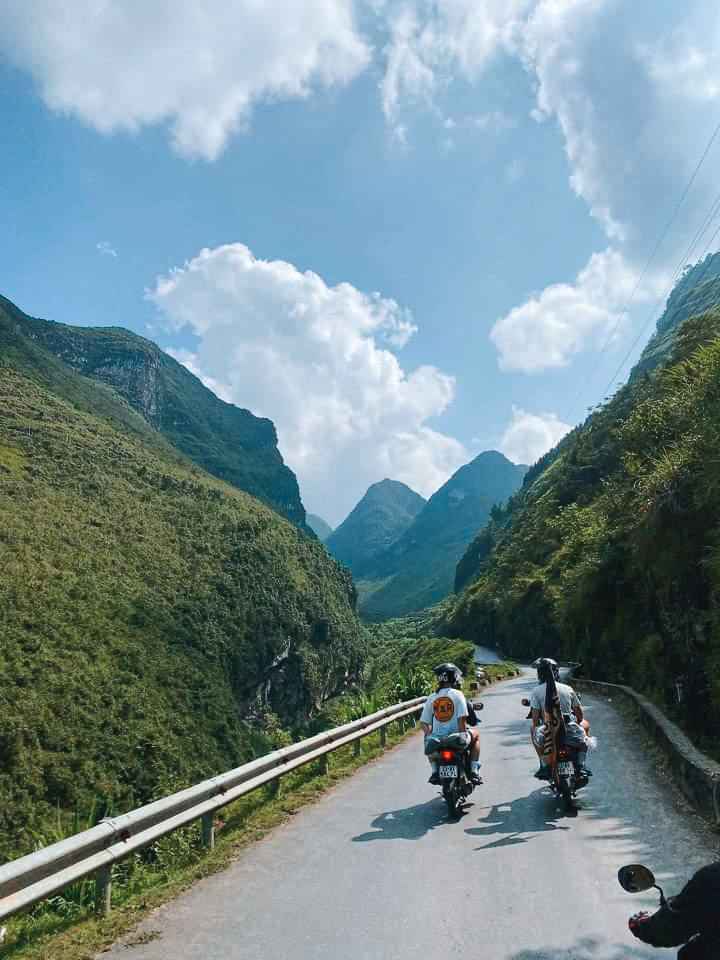
If you’re even a little unsure about driving or just want to kick back and enjoy the ride, a guided tour is such a great way to do the Loop. You can hop on the back of an easy rider’s bike (aka a local pro driver), soak up the views, and not worry about navigating sharp curves or muddy paths.
Plus, these tour guides know the roads like the back of their hand, they’ll take you to viewpoints, waterfalls, and off-the-map spots that you’d probably miss on your own.
Tours usually come as a package deal too, which is super convenient. Most companies take care of:
- Accommodation (usually cozy homestays)
- Meals (delicious local food, often shared with your group)
- Routes and stops (you’ll hit all the highlights and a few secret gems)
- All the logistics (no worrying about fuel, bike maintenance, or directions)
One of the coolest things was that every tour seemed to carve its own unique path. On my trip, we crossed paths with other groups going in totally different directions. So even though you’re doing the same loop, everyone’s experience is a little different which makes it feel even more personal.
Most tours also offer a safety and security buffer on the mountains. The Ha Giang loop roads are known for being quite dangerous, especially in the case of rain that causes potential landslides and flooding.
Some popular Ha Giang loop tours include:
Having a tour group to navigate the dangers of the road reduces the chance of being stranded or stuck anywhere in a worst-case scenario. The drivers know many routes to any location on the maps and have experience driving through all weather conditions in the mountains.
If you’re still keen to ride your own bike but want the structure and support of a group, most tour companies offer a “drive yourself” option too. That way, you can still cruise at your own pace while staying with the group and benefitting from the guide’s local knowledge. Best of both worlds, really.
You can look at tours on booking.com or getyourguide. I would also recommend looking at which companies you would be interested in going with and messaging them.
Self-Driving Through Ha Giang Loop
If you’re someone who loves the idea of being totally in control of your own adventure, then self-driving the Ha Giang Loop might be the choice for you. Riding solo (or with friends) through the mountains gives you complete freedom. You get to choose when to stop, which detour to take, and how long to hang out at each small village or viewpoint.

There’s something really special about being able to take your time and explore Ha Giang at your own pace. Whether you’re into photography, spontaneous stops for roadside noodles, or simply pulling over to take in the silence of the mountains, you can do it your way.
There are just a few logistics to sort out before hitting the road.
Renting a Motorbike For the Ha Giang Loop
If you’ve decided that self-driving is your jam and you’re ready to hit the road solo (or with a travel buddy), then your next step is renting a motorbike. Luckily, Ha Giang City is kind of the motorbike rental capital of the north. There are tons of shops offering bikes specifically for doing the Loop.
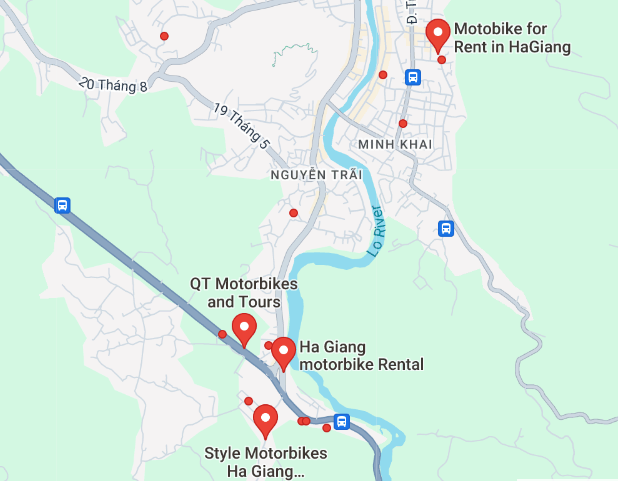
Once you arrive in Ha Giang, take a bit of time to shop around. Walk into a few rental places, ask questions, and compare what they offer. Not all bikes or rental policies are created equal, so it’s worth being a little picky here. You’re about to ride through mountain passes, rocky curves, and remote areas, so you’ll want a bike that feels solid and safe.
Here are a few things I’d recommend checking before committing to a rental:
- Cost: Prices can vary depending on the type of bike, how long you’re renting, and the rental shop. Most are pretty affordable, but it never hurts to bargain a little!
- Insurance: Ask what’s covered, especially if the bike gets scratched or damaged. Some shops include basic coverage, others don’t.
- Condition: This is so important. Check the brakes, lights, tires, and horn. Give the bike a little test ride if you can. A bike that breaks down halfway up a mountain = no fun.
- Manual or automatic: Go with what you’re most comfortable riding. If you’ve never driven a manual before, now’s probably not the time to learn.
If you’re the kind of person who likes to have things sorted before arrival, you can absolutely book your motorbike in advance. Sites like Booking.com often have listings for bike and car rentals in Ha Giang with reviews you can read through first. It’s a good way to ensure you’re going with a reputable place.
Whichever route you take, just remember: the bike is your best friend for the next few days, make sure it’s a reliable one!
Food and Stay on the Ha Giang Loop
One of the coolest things about doing the Ha Giang Loop (aside from the insane views) is how connected you’ll feel to the local communities along the way. The entire route is dotted with small towns and local villages tucked into the mountains and many of them are growing to accommodate travelers on the loop.
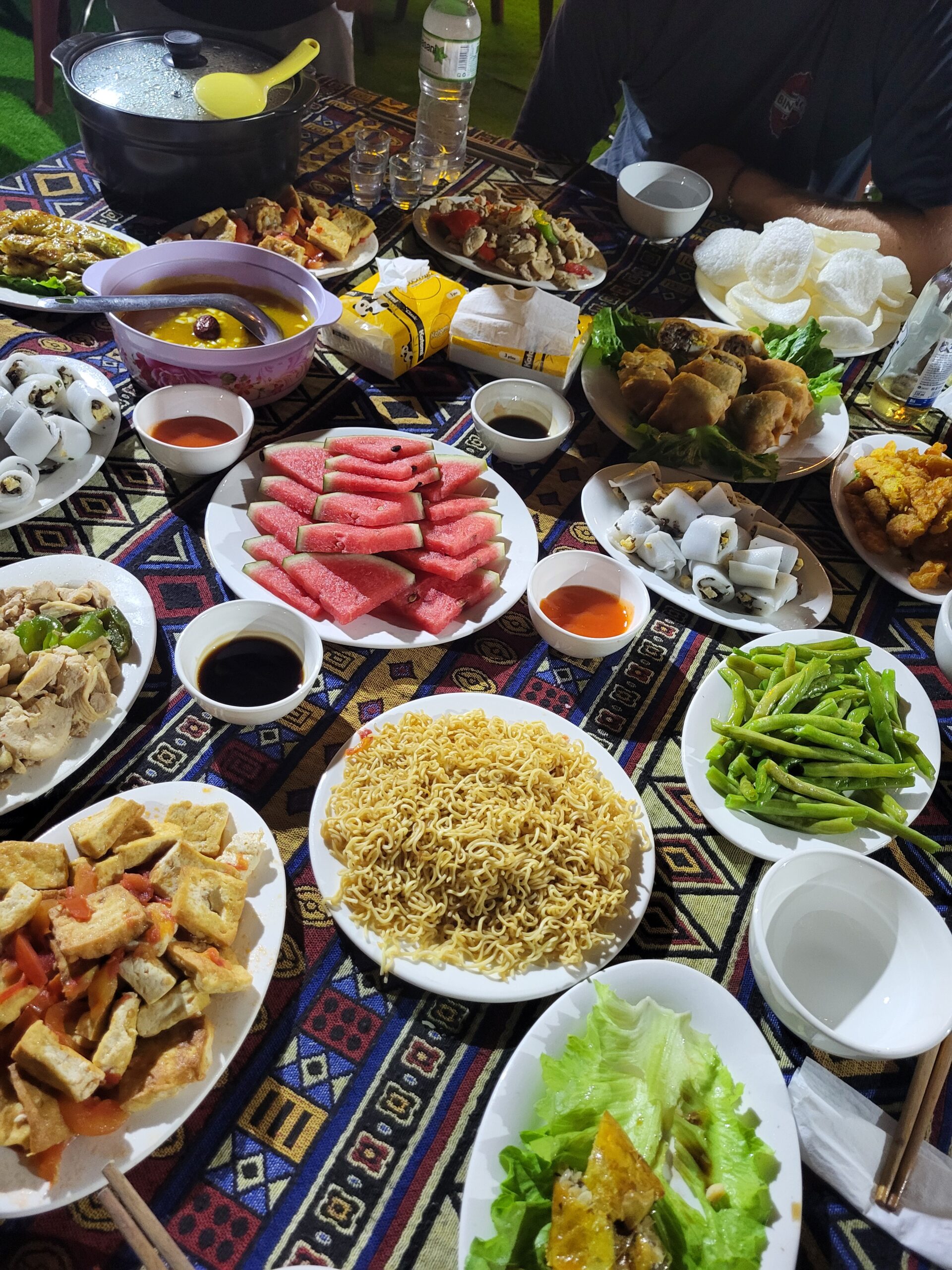
As the Loop has gained popularity, more shops, markets, homestays, and even cute roadside cafés have started popping up. Most towns you pass through will have at least one local homestay or guesthouse, and many offer dinner and breakfast included, which makes things super easy after a long day of riding.
You’ll also find little markets and food stalls where you can grab snacks, drinks, and quick bites. Eating fresh, simple Vietnamese dishes while sitting outside surrounded by mountains was one of my favorite parts of the experience.
I did the Loop as part of a tour, so everything (meals, accommodations, routes) was already planned out for me. It was amazing, but it does mean I didn’t get to explore as much of the solo logistics myself.
If you’re planning to ride the Loop on your own and want all the nitty-gritty info (like where exactly to stop, what to eat, or how to navigate solo), I recommend checking out The Relentless Beans Blog.
Ha Giang Loop Road Conditions
Now, let’s talk roads. The Ha Giang Loop is absolutely stunning, but it’s not always smooth sailing. The Ha Giang Loop roads are known for being quite dangerous. You are riding through mountain passes, very remote areas of the North, and in some cases, a cliff edge! Sometimes the roads are less road and more dirt paths to follow, which can lead to some difficult driving.
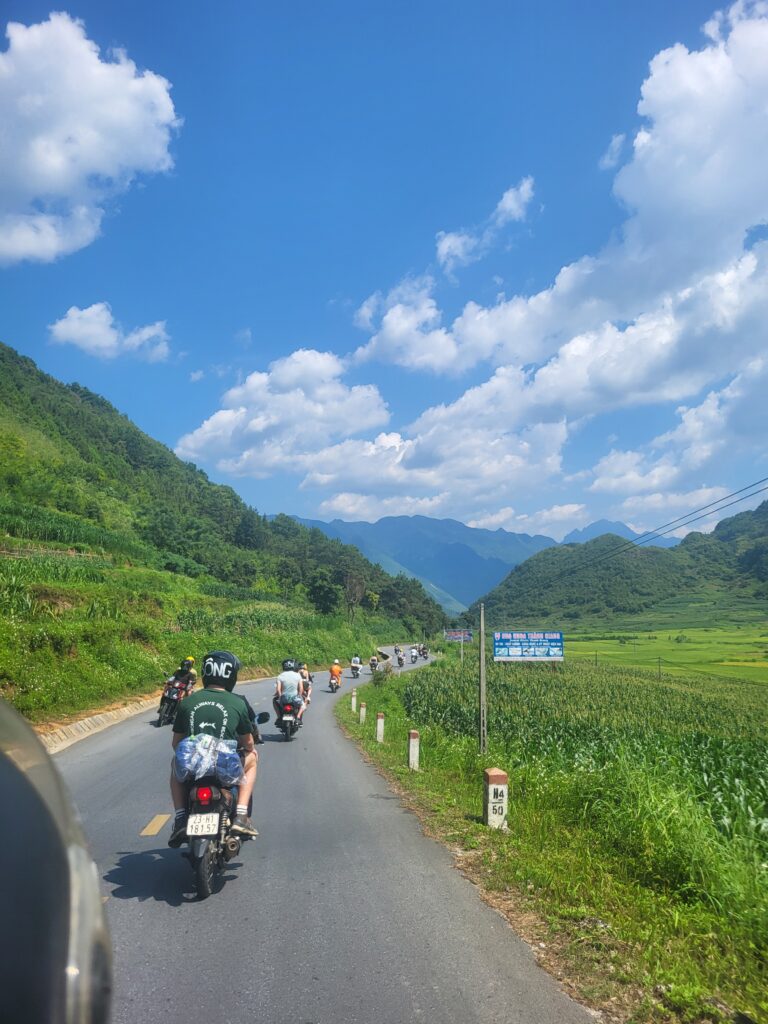
The roads vary quite a bit:
- Some are narrow roads and winding, hugging cliffs with no guardrails—super scenic but also a bit sketchy in the rain.
- There are main roads that are paved, connecting bigger towns, which are generally easier to ride.
- You’ll also encounter deep valleys and steep climbs that demand some confidence and caution on the throttle.
That said, if you’re a confident rider or have done a bit of motorbiking before, it’s definitely doable. Just take your time, watch the weather, and don’t push your limits, especially on unfamiliar terrain.
Caution on the Ha Giang Roads
I want to give caution to everyone looking into the loop adventure. The Ha Giang Loop is one of the most unforgettable experiences you can have in Vietnam. It is an amazing journey, filled with so much inspiration, beauty, and scenery.
I will 100% recommend it to everyone visiting or who’s even thinking about visiting North Vietnam because it truly is an experience second to none. However, it does come with its dangers. This isn’t your typical scenic Sunday drive. The Loop is also known for being a little bit… intense.
Weather: When the Skies Turn on You
The weather up in the mountains can change fast. One minute it’s sunshine and sweeping views, the next it’s misty rain and slippery roads. If it really starts to pour, some sections of the road can literally turn into rushing streams. Like any mountainous region, that also means there’s a risk of landslides when the rain gets heavy.

Even if you’re riding with an experienced guide, be prepared. If you’re driving yourself, definitely check the weather forecast each day and don’t be afraid to take it slow or pause your trip if things look stormy.
Police Checks and Road Rules
If you’re planning to drive the Ha Giang Loop yourself, I would caution you about the police around the mountains: police road checks are a thing out here. You’ll likely come across a few checkpoints, especially in more remote areas. They’re usually just quick stops where police are checking for valid documents.
To legally ride a motorbike in Vietnam, you’re supposed to have:
- Your regular driver’s license
- An International Driving Permit (IDP) with motorcycle endorsement
- A valid motorcycle license
If you’re missing one of those, there’s a chance you could be fined or stopped from continuing. Some people ride without all the right documents and make it through just fine, but it’s a bit of a gamble, so just be aware of that risk and make sure you’re as prepared as you can be.
Travel Insurance
One thing you definitely shouldn’t skip is travel insurance. I know, it’s not the most exciting part of trip planning, but trust me, it’s important. The Loop is Vietnam’s most epic adventure. But it’s also not without its risks.
You’ll be riding a motorbike through some pretty remote areas, and the roads can be steep, narrow, and sometimes in rough condition. Add in unpredictable weather, sharp turns, and the occasional herd of cows, and, well… things can go wrong.
Even if you’re a confident rider, accidents happen. And if they do, you might end up facing medical costs, bike damage, or needing to be transported to a hospital far away. That’s where travel insurance comes in. It can cover medical expenses, emergency evacuation, lost belongings, and even trip cancellations. Basically, it’s your safety net.
Best Months to Ride the Ha Giang Loop
The best time to do the Loop, in my opinion, is during the dry season, from October to April. The skies are clearer, the roads are safer, and the views? Unreal. The whole experience gave me major “this is what I came to Southeast Asia for” vibes.
Northern Vietnam has distinct seasons, and the best time to travel depends on the kind of experience you’re after.
- Best months: October–November and March–April.
- Avoid: June–August if you want to skip the rain and heat.
- Cold alert: December–February in the mountains can get chilly!
Here’s a breakdown of the seasons in Vietnam:
Autumn (October – November)
Best time to visit! But this is also high season.
- Cool, dry weather and stunning golden rice terraces (especially around Sapa and Ha Giang).
- Crisp mornings and blue skies—perfect for hiking and motorbiking.
- Ideal for doing the Ha Giang Loop or trekking in the mountains.
Winter (December – February)
- It can get cold, ranging between 5–15°C (40–60°F)
- Still dry, so the roads are safe and the skies are clear.
Spring (March – April)
- Warming up again, but still pleasant and not too humid.
- Beautiful blossoms and greenery are returning to the hills.
- Another great time for the Loop and exploring more remote areas.
- Bonus: Fewer tourists than in autumn!
Summer (May – September)
- Hot, humid, and rainy season.
- Expect heavy showers, especially in the afternoons.
- More risk of landslides and road conditions can be tricky (especially on mountain routes like Ha Giang or Sapa).
This motorbike tour was and forever will be a happy memory for me. The people, the great food, the local culture, and the landscape all tie together into the best experience.
Vietnam Extras
Vietnam is an absolutely amazing country. As a solo female traveler, I’m always very weary of who I’m with, where I am, and so on. However, my time in this country was filled with so much joy and awe. Although it can be busy, it surpassed my expectations with its charm, safety, and amazing range of natural landscapes.
Accommodation
I use hostel world when looking for hostels or private rooms when I travel. Especially in Vietnam, it has proven to be the easiest and cheapest way for me to book my accommodations.
I have also been recommended to use Agoda by multiple people for hostel/hotel booking in Asia. It is a competitor app for travel booking so it has some amazing prices!
Sim Card
You can buy SIM cards at most airports, but e-sims are easier to get data in other countries. You can buy your plan before you go to any country, and you have data ready for you as soon as you land. Airalo is great for e-sims, it covers over 180 countries and is so easy to use!
Transportation
Grab is the “Uber” of Vietnam. They have competing prices so it’s good to check out both!
Vexere is also the local app for booking overnight buses between major cities. It’s half the price of booking transportation with hotels or hostels.
Related Posts
Now, I have many places and cities in Vietnam I can recommend! If you’re interested in where else to go, check out my posts about the following:
- Discover the duck stop: A Unique Experience in Vietnam
- Unique Activities to do in Phong Nha, Vietnam
- The Most Amazing Experience Making Vietnamese Coffee Recipes
- Beautiful Places to go to in Vietnam: Ninh Binh
- A Unique Vietnam Experience in Phong Nha: The Dark Cave Tour
- Basic Vietnamese words and Phrases to learn for your Trip to Vietnam

